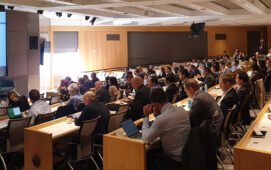By David Campbell, Securities Product Manager, Investment Services and Nolan Gesher, Senior Product Manager, Risk and Compliance, Fiserv
In 2009, 70% of all OTC derivatives trades were subject to collateral agreements, proving significant challenges. The lack of standardised processes, which can be a burden, also provides opportunities. By using systems and processes to address the lack of standardisation, institutions can increase operational efficiency and ensure increased customer satisfaction.
The buy side in particular faces huge challenges brought on by highly manual, spreadsheet driven processes and a general lack of systems. Even where there are systems in place, integration of those systems and data still pose problems. The buy side historically likes to be left to its own devices rather than spend their time focusing on processes and systems.
The occasional prod from regulators or other interested parties is to be expected and they’ve been happy to comply. The marketplace is changing –the rise of collateral management and increased use of OTC derivatives brings about challenges which need to be addressed early on so that the industry is not seen to be on the back foot and can quickly reap the benefits.
So what about OTC derivatives? The valuation and accounting of OTC positions bring their own trials and tribulations. Valuation is often problematic without a standardised industry approach. As each institution has its own interpretations and references. We are therefore faced with a highly sophisticated, complex and subjective proposition. A recipe that can certainly lead to disaster, or at best it becomes a process of ‘best fit’ for now.
The need to accurately account for OTC positions directly impacts your trading ability as it determines what collateral you give or take. The decision as to what collateral you give or take is also often more about what can be used other than cash? And how do I optimise my assets? Around 80% of collateral is still given in cash. The use of equities and bonds is increasing but firms are looking to establish clearer systems and processes that look at all possibilities as standard rather than presuming cash is easiest and best.
Collateral agreements are often unilateral for the buy side, which means that the buy side institution has to post collateral to the broker or bank if its position becomes profitable. When the situation is reversed, the sell side does not reciprocate which is likely to remain the same for the near future. Another difficulty for the buy side comes when asking firms to have the capabilities to enter, monitor and utilise all the terms (such as thresholds based on fund NAVs) correctly and according to the deadlines (also in the CSAs). It is this operational/computational overlay that could bring the additional value to the buy side.
Improving operational efficiency and becoming more aware of collateral management issues has come to the fore. Now is the time for the buy side to make significant strides into tackling the art of sophisticated collateral management.
The buy side is growing up in terms of processing and reporting and has much to bring to the table in terms of developing systems that will improve performance, an essential criteria for hedge funds.
The good news is that assets under management (AUM) are now back and creeping above the levels witnessed pre crisis. As AUM increase, so does confidence and returns which are often brought about by more complex trading strategies. Self-belief and arrogance were words much bandied about during the crisis and it is essential that systems are in place that do not allow or enable a blind return to such days where anything went as long as it appeared to make top line profits. Questions need to be asked of both the strategies and the risk management and operating systems that are supporting them.
Buy side risk managers are faced with a very different job in a post crisis market. Where reconciling collateral positions were once done on spreadsheets, increasing compliance and efficiency pressures have made this an area that needs control for auditing and cost purposed. Timely reconciliations is the cornerstone of managing risk around collateral management particularly to ensure that counterparties agree on the value of collateral and should be a key focus for automation. No longer is it just a box ticking exercise. Today it is goes further. For example, they need to know exactly what collateral has been pledged, they should have an analysis of it to hand and be able to intelligently determine what needs top tier capital and what can be reconfigured. Today it is all about ‘smart collateral management’.
For buy side risk managers, smart collateral management is crucial as trading moves more and more from unsecured to secured. This all needs state of the art tools for valuing assets and monitoring risk.
Firms have difficulties determining its true risk exposure as they lack an enterprise wide view because most of their systems reside in silos. Part of this is cultural desks are naturally competitive and secretive about their strategies as are their risk managers, part of it has been a lack of understanding of enterprise wide risk management. In the current marketplace risk and reporting issues are headline items and the systems and processes within firms need to reflect this.
As a result of the crisis, counterparty risk has been pushed to the top of the agenda. Firms must have a clear understand of where its collateral resides. One of the fundamentals of smart collateral management is being able to monitor counterparty risk. As we all know, the same collateral has often been used to support multiple instances of counterparty risk, but what happens when the systems break down?
The landscape for collateral management is still plagued by operational challenges without standardised or automated processes. Determining collateral and accounting for OTC derivatives is formulated on an individual basis. By adding the volatility of asset prices into the mix, concerns around counterparty risk increase.
How is a utopian of smart collateral management achieved? There are myriad of places to start. Do you have existing platforms within the group that can be used e.g. interdealer broker platforms?
You can scope out third party software or build your own. Alternatively you can partner with a third party or use asp delivered software. The exact combination is largely determined by your objectives and structure. There is no single, straight answer.
Have no fear there, asset servicers can offer a helping hand. The asset servicing community can help the buy side with all of the issues outlined previously: the lack of systems, the integration of data sources and systems, the valuation of OTC positions, the accounting for OTC positions, the impacts on collateral to give or take, what collateral to give or take, what can be used other than cash and how to optimise and the integrating of collateral with other outsource capabilities.
There are a few options available – fully outsource the middle and back office for OTC and collateral management or provide platforms for the buy side to use in conjunction with outsourced capabilities.
The combination of outsourced or in-sourced you choose is determined by a number of factors: cost, the need for flexibility, existing in house systems and the capabilities of your technology vendors, in house capabilities to integrate multiple sources of information and data streams, the size of your skilled workforce to process and manage OTC derivatives and collateral, your risk profile, outside regulation and internal audit controls among other criteria.
One of the cornerstones greater operational efficiency and stability is smart collateral management. It is a key ingredient for better customer service which leads to maintaining and growing AUM.
A strategic approach must be taken to management collateral and OTC derivatives. In 2009, the ISDA confirmed that US$3.2 billion was used as collateral to mitigate credit risks in the OTC derivatives market.
The key is to standardise where possible, for example ISDA agreements, reference data points, time stamps and so on. Automate where you can. Anything to do with OTC derivatives and collateral management has always been associated with highly manual processes. Can you automate and standardise it all? No. However, look to the OTC derivatives in play, generally speaking around 90% of them are vanilla and these can be standardised and automated. If you managed to get even close to that, imagine the amount of intelligent resource you could free up to do value add activities – those subjective decisions that need a human touch. They would also be freed up to deal with the more complex derivatives and difficult collateral management decisions.
Smart collateral management is about becoming as efficient and risk aware as you can be. The smart money is on those who embrace the cultural change needed and are willing to put the systems and processes in place that will ultimately lead to better customer service. It also bodes well for being able to tackle any stress points that might lie ahead in the future.
Subscribe to our newsletter




